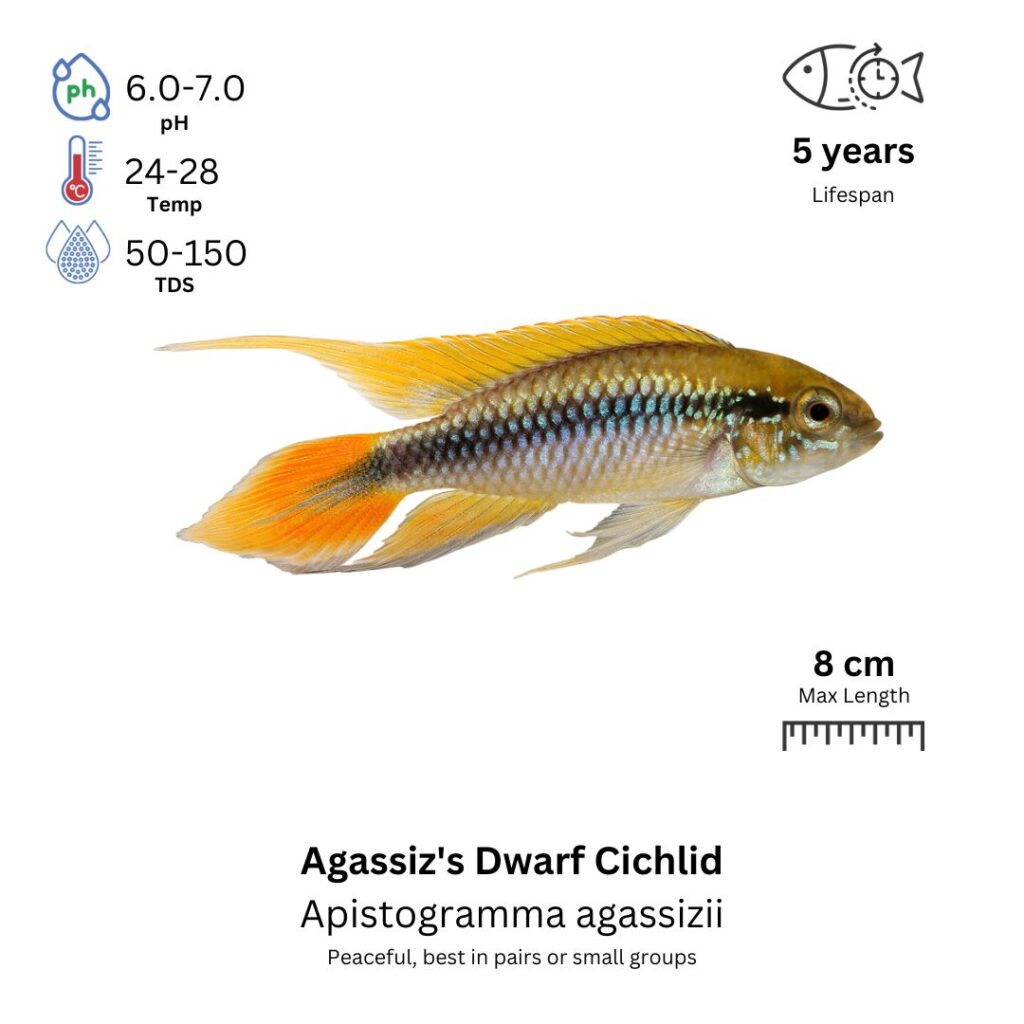Agassiz's Dwarf Cichlid
Apistogramma agassizii

Description
Agassiz’s Dwarf Cichlid is a stunning and popular species of South American cichlid known for its vibrant colors and small size. The body of this species is typically yellowish to light brown with horizontal black or dark brown stripes running along its body, giving it a striking appearance. Males tend to be more colorful than females, often showing bright orange, red, and blue hues, especially around the face, dorsal fin, and tail. Females are usually more subdued in color but still display subtle yellow and brown tones. Their small size and bright colors make them a popular choice for aquariums that feature peaceful community setups.
Habitat Origin
Native to the rivers and streams of the Amazon Basin in South America, Agassiz’s Dwarf Cichlid is typically found in slow-moving, clear waters with a lot of vegetation and submerged structures like roots and branches. They are usually found in slightly acidic to neutral water, preferring environments with moderate to low water flow. In their natural habitat, these cichlids seek refuge among plants and rocks, where they can establish territories and forage for food.
Aquarium
Ideal Number in Aquarium: Ideally kept singly or in pairs. If in a community setup, ensure plenty of hiding spots and space to avoid aggression.
Favorite Food

Agassiz’s Dwarf Cichlids are carnivores and will accept a variety of foods. They can be fed high-quality cichlid pellets, frozen or live foods such as brine shrimp, daphnia, bloodworms, and grindal worms. They may also graze on small invertebrates and plant matter, so providing vegetable-based foods like spirulina or blanched zucchini will also benefit them. Offering a varied diet will help maintain their vibrant coloration and overall health.
Behavior:
Agassiz’s Dwarf Cichlid is a peaceful, but territorial fish, especially when they are establishing breeding territories. During breeding, males become more colorful, displaying vibrant orange and red hues, and may defend their territory aggressively. In general, they are relatively peaceful towards other species in a community tank, but they will defend their space from other cichlids or tankmates that invade their territory. When kept in pairs, they are often seen engaging in courtship displays and caring for their young, which adds to the appeal of keeping them.
Special Care:
Agassiz’s Dwarf Cichlids do best in aquariums that have plenty of hiding spots, such as caves, driftwood, and plants. Providing a peaceful, stable environment with good water quality is essential for their well-being. Regular water changes, good filtration, and a well-maintained tank are crucial to maintaining water conditions that support the health of this species. It is also recommended to provide areas of soft substrate, as they may dig to create nesting sites or secure their territory.
Compatibility with Other Fish:
Agassiz’s Dwarf Cichlids are peaceful with other species but should be housed with non-aggressive fish that will not intrude on their territory. They can be kept with small to medium-sized peaceful species such as tetras, rasboras, small catfish, and shrimp. It’s best to avoid housing them with other cichlids unless they have enough space to establish separate territories. These fish are best suited to peaceful community tanks with plenty of plants and hiding spots to reduce stress.
Breeding Tank Setup
A separate breeding tank is highly recommended for Agassiz’s Dwarf Cichlids due to their territorial behavior during spawning. A 40–60 liter (10–15 gallon) tank provides enough space for pair bonding and territory establishment. Maintain a pH of 6.0–7.5, temperature of 24–28°C, and soft to moderate hardness (4–12 dGH). Use a sponge filter for gentle water movement and safe filtration for fry. Fine gravel or sand substrate is ideal, along with smooth stones, caves, or ceramic tubes to support cave-spawning behavior. Add live plants like Anubias or Java moss for cover and comfort, and use moderate lighting with shaded areas to mimic natural habitats.
Selecting Breeders & Conditioning
Conditioning is essential to stimulate spawning. Feed the breeding pair a protein-rich diet of live or frozen foods such as brine shrimp, bloodworms, and daphnia. Supplement with high-quality cichlid pellets or flakes. Perform weekly water changes (20–30%) and slightly raise the temperature to 28°C before introducing the pair. Ensuring soft, clean water replicates their native Amazon conditions and encourages natural breeding behavior.
Spawning Process
Spawning usually occurs early morning or late night once the pair is comfortable. The male displays his colors and courts the female until she lays 50–150 eggs in a hidden location such as a cave or leaf. After spawning, do not separate the parents—Agassiz’s Dwarf Cichlids exhibit strong parental care. The female guards the eggs, fanning them with her fins for oxygenation, while the male defends the territory. This cooperative behavior is key to successful hatching and early fry protection.
Fry Care & Feeding
Eggs hatch within 2–3 days, depending on temperature. Once the fry become free-swimming, feed them infusoria or liquid fry food for the first few days. As they grow, introduce newly hatched brine shrimp, microworms, or finely crushed flakes. Keep water quality high with 10–15% water changes every 2–3 days, and maintain stable temperatures (24–28°C). Continue using a sponge filter to avoid sucking up the fry and prevent strong currents that could stress them.
Maturity, Sexing, and Stress Management
Agassiz’s Dwarf Cichlids are ready to breed at 6–9 months of age, though it’s best to wait until they are fully mature for optimal outcomes. Males are more colorful, with extended fins and striking red, yellow, or blue markings, while females are rounder and more subdued in coloration, especially when gravid. To prevent stress, avoid overcrowding, sudden water changes, and aggressive tankmates. A calm, stable environment significantly increases the chances of successful breeding and healthy fry development.
